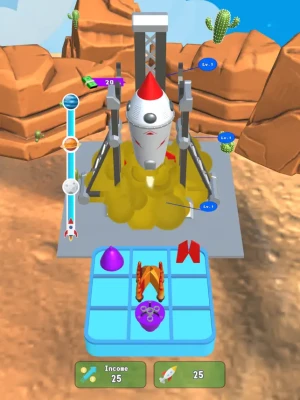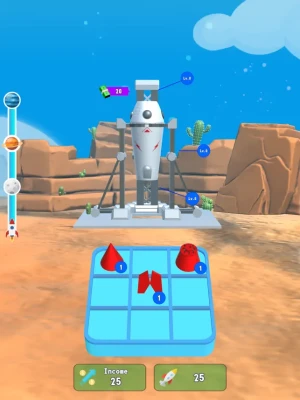
Latest Version
0.1
May 11, 2025
Build your rocket and launch!
Games
iOS
96.8 MB
0
Free
Report a Problem
More About Rockets Up!
Discover the Wonders of Our Solar System: A Journey Through the Planets
Embarking on a journey through our solar system offers a unique opportunity to explore the diverse planets that orbit our sun. Each planet possesses its own distinct characteristics, making them fascinating subjects of study and exploration. In this article, we will delve into the wonders of these celestial bodies, highlighting their unique features and the mysteries they hold.
The Inner Planets: Mercury, Venus, Earth, and Mars
The inner planets, also known as terrestrial planets, are composed primarily of rock and metal. They are located closer to the sun and include Mercury, Venus, Earth, and Mars. Let’s take a closer look at each of these intriguing worlds.
Mercury: The Swift Planet
Mercury, the closest planet to the sun, is known for its swift orbit, completing a revolution in just 88 Earth days. Despite its proximity to the sun, Mercury experiences extreme temperature fluctuations, with daytime temperatures soaring to 800 degrees Fahrenheit and plummeting to -330 degrees Fahrenheit at night. Its surface is marked by craters, similar to our moon, revealing a history of impacts and geological activity.
Venus: Earth's Twin
Often referred to as Earth's twin due to its similar size and composition, Venus is shrouded in thick clouds of sulfuric acid, creating a greenhouse effect that raises surface temperatures to around 900 degrees Fahrenheit. This hostile environment makes it one of the least hospitable places in the solar system. However, its stunning beauty, with bright clouds and reflective surface, continues to captivate astronomers and space enthusiasts alike.
Earth: Our Home Planet
Earth is the only planet known to support life, thanks to its perfect distance from the sun, which allows for liquid water to exist. With a diverse range of ecosystems, from lush forests to arid deserts, Earth is a treasure trove of biodiversity. Its atmosphere, rich in oxygen, protects life from harmful solar radiation and helps regulate temperature, making it a unique haven in the cosmos.
Mars: The Red Planet
Mars, often called the Red Planet due to its iron oxide-rich surface, has long fascinated scientists and explorers. With the presence of polar ice caps and evidence of ancient riverbeds, Mars may have once harbored conditions suitable for life. Current missions aim to uncover the planet's secrets, including the search for microbial life and the potential for human colonization in the future.
The Outer Planets: Jupiter, Saturn, Uranus, and Neptune
Beyond the asteroid belt lies the outer planets, also known as gas giants, which include Jupiter, Saturn, Uranus, and Neptune. These massive planets are primarily composed of hydrogen and helium and possess unique features that set them apart from their inner counterparts.
Jupiter: The Giant of the Solar System
Jupiter is the largest planet in our solar system, boasting a diameter of about 86,881 miles. Its most famous feature, the Great Red Spot, is a colossal storm that has been raging for centuries. Jupiter's strong magnetic field and numerous moons, including the largest moon Ganymede, make it a focal point for astronomical research and exploration.
Saturn: The Ringed Beauty
Saturn is renowned for its stunning rings, composed of ice and rock particles. This gas giant is the second-largest planet in our solar system and has a complex system of moons, including Titan, which is larger than the planet Mercury. Saturn's unique beauty and intriguing features make it a favorite subject for astronomers and space enthusiasts.
Uranus: The Tilted Planet
Uranus stands out due to its extreme axial tilt, which causes it to rotate on its side. This unique orientation results in unusual seasonal changes and extreme weather patterns. The planet's blue-green color is attributed to methane in its atmosphere, and it possesses a faint ring system and numerous moons, adding to its allure.
Neptune: The Mysterious Blue Planet
Neptune, the farthest planet from the sun, is known for its deep blue color and strong winds, which can reach speeds of over 1,200 miles per hour. This gas giant has a dynamic atmosphere with storms and clouds, making it a subject of ongoing research. Its moon Triton is particularly interesting, as it is believed to be a captured object from the Kuiper Belt.
The Future of Planetary Exploration
As technology advances, the exploration of our solar system continues to evolve. Missions to Mars, the outer planets, and beyond are paving the way for a deeper understanding of these celestial bodies. The potential for discovering extraterrestrial life and understanding the origins of our solar system drives scientists and space agencies to push the boundaries of exploration.
Conclusion: Embrace the Adventure of Space Exploration
Exploring the planets of our solar system is not just a scientific endeavor; it is an adventure that ignites the imagination and inspires future generations. Each planet offers a unique glimpse into the complexities of our universe, encouraging us to rise up and embrace the wonders of space. As we continue to explore, we uncover the mysteries of the cosmos, reminding us of our place in the vast expanse of the universe.
Rate the App
User Reviews
Popular Apps










Editor's Choice































